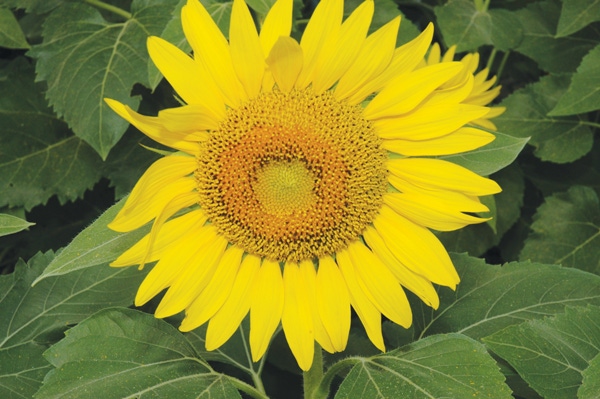September 21, 2010

Sunflowers attract a lot of attention because of their beauty and the rotation of their heads with the sun, but their versatility is starting to turn producers' heads too, according to a Texas AgriLife Extension Service agronomist.
Calvin Trostle, AgriLife Extension agronomist in Lubbock, works with a number of crops, but his expertise with sunflowers has him burning up the pavement between Etter to the north and Lamesa to the south with experimental trials as interest grows.
"AgriLife Extension has been testing sunflower hybrids for both confectionary and oilseed yield since about 2002, but starting in 2008, Texas AgriLife Research added sunflower to our official crop-testing program where companies pay to have their hybrids tested," Trostle said.
That testing in Texas is currently offered for the Dumas, Lubbock, Corsicana and Corpus Christi areas, but the primary focus and the largest tests are the High Plains sites, he said.
"It was a significant change for me when Texas AgriLife Research added sunflowers to the crop testing program in 2008," Trostle said. "Over the three years of the program, we have averaged nine confectionary hybrids and about 24 oilseed hybrids per year."
The number of entries is up compared to past years as Texas sunflowers are drawing interest from more of the Dakota-based seed companies who are either interested in expanding sales into the Texas market or testing their hybrids at more southerly locations where heat is usually much higher than in the Dakotas, he said.
Seed company entries
The program allows seed companies to enter their products into crop trials and then specialists, such as Trostle, provide data on yields, oilseed sunflower oil content, or the ratio between the large and small confectionary seed.
Trostle is also working with U.S. Department of Agriculture in Fargo, N.D., on a project in Lubbock to screen for the sunflower head moth. They have found that some sunflowers are less susceptible to damage from the insect.
"We tend to have more of a problem here than in the Dakotas," he said.
In trials at the North Plains Research Field near Etter, Trostle is evaluating both confectionary and oilseed sunflower hybrids for producers.
"We are interested in the larger seed size for the confectionary," he said. "The sunflowers in a test like this where we have many different types of confectionary varieties or hybrids are evaluated not just for yield in terms of what farmers would be paid for, but also for the size of the seed."
Larger confectionary seed is usually worth about 50 percent more than the smaller seed, Trostle said.
Nationally, there are about 1 million acres annually of oilseed sunflowers and 400,000 to 500,000 acres of confectionary. But in Texas, the acreage is usually about 60 percent confectionary due to proximity to the confectionary market, while there is only one small sunflower seed crushing facility at Brownfield. The rest must go to Lamar, Colo., or Goodland, Kan.
Texas High Plains sunflower acreage fluctuates from 40,000 to 100,000 acres a year depending on the price for sunflowers, as well as the price of competing crops such as cotton in the South Plains or corn in the Panhandle, Trostle said. The statewide total ranges from 60,000 to 125,000 acres.
Historically, the heaviest producing counties are Lamb and Bailey in the northwest South Plains, Lynn and Dawson counties south of Lubbock, and Moore and Dallam counties in the Panhandle.
Sometimes a catch crop
Sunflowers are a primary crop for some, but many use it as a catch crop—something to plant after a failed grain or especially cotton crop. In 2010, only about 10 percent of the sunflowers were planted as a catch crop. But in 2009, probably 25 percent was a catch crop and in 2008, "we had a huge amount of late-planted sunflower."
That is part of the attraction to sunflowers, Trostle said. They have a very long and late planting window, from early April to mid-July. And sunflowers are not injured by a light freeze, so they continue to grow and add yield and oil content when the same temperature on a sorghum crop would cause severe injury or even kill it.
It takes sunflowers about 120 days from planting to harvest, he said. Sunflowers can be planted about 10 days earlier in the spring around Lubbock than in the northern Panhandle as well as about 10 days later in the summer. So April sunflowers are likely harvested in August, but July sunflowers, because they will not shut down until a hard freeze, might not be harvested until November.
Trostle said growing sunflowers is not and should not be for everyone, but it does make sense on limited irrigation because the crop effectively roots to at least 6 feet deep and can scavenge for nutrients and moisture deep in the soil well below the reach of corn and even cotton.
The National Sunflower Association has a goal of increasing Texas sunflower production to diversify the region in the U.S. where sunflower is grown, he said.
"A larger oilseed crushing plant here would make a major difference," Trostle said.
He said Producers Co-op Oil Mill in Oklahoma City is hoping to expand into crushing Texas sunflowers when they move to a soon-to-be-built facility outside Oklahoma City.
More information about growing sunflowers in the High Plains can be found at http://lubbock.tamu.edu/sunflower.
You May Also Like




